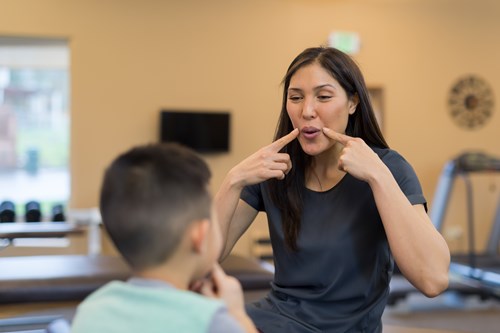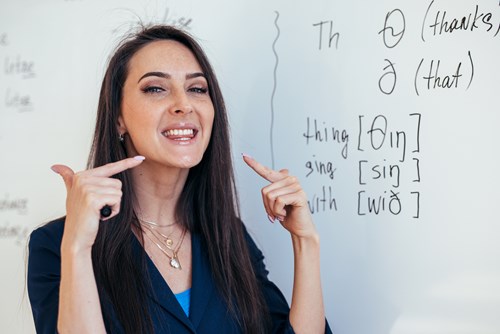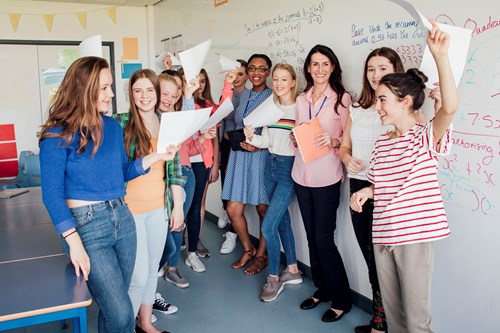Making pronunciation a physical ability
You may have read or heard that pronunciation is a physical or kinaesthetic activity, but what exactly does that mean for teachers? And does that mean we have to be getting students jumping around in lessons? In this blog, Gerhard explores the physical nature of pronunciation and what exactly is meant by making pronunciation physical.
In a recent Twitter thread, I noticed a small survey where teachers were asked a few questions. While I agreed generally with the answers, a large percentage of the teachers disagreed with the statement ‘Pronunciation is kinaesthetic.’ Now, I would disagree with that statement too, but the discussion that followed made me realise that the problematic word for me was kinaesthetic, so I asked around to see what other teachers thought. Surprisingly to me, quite a few of my trainees from previous courses agreed with the statement, saying we had done quite a bit of work on how pronunciation is a physical activity. On further inspection, that was taken to mean that students often need to be physically active when doing pronunciation work, and the purpose of this blog is to highlight why that is not true, and how the statement ‘Pronunciation is physical’ has been misconstrued into kinaesthetic. This is not a discussion on learning styles, which I quite strongly disagree with, nor is it a discussion on multi-modal instruction, which I quite strongly agree with, but purely a discussion of what it means to make pronunciation physical.

Language systems
Language systems are grammar (or morphosyntax), lexis (vocabulary), phonology (pronunciation), discourse (how texts are structured), and function (why we say or write certain things). If you think about proficient users, grammar and lexis are subconscious processes, meaning you don’t have to think about every word before you say it, and you don’t actually think about grammar rules when you are speaking, and perhaps not even when writing (except for very formal or academic writing). Function to a large extent is also subconscious, unless you are ‘choosing your words carefully.’ Discourse is perhaps slightly more conscious as we actually think about where to find things in a text or make predictions on what will be said or written later based on our prior experiences and knowledge. This is an over-simplification but is highlighted here to help us consider the role of pronunciation and why it should be considered physical.
If we think about it, it is quite clear that chunking, and adjacency pairs, and all of the ideas around how language works are subconscious and the easier it is for us to access that at speed, the more fluent we become. Eventually you stop translating in your head, and you can hold a conversation without having to think about how or what to say in the other language. Except, your muscles still have to actually produce the sounds of what you want to say, and that makes pronunciation physical.

Playing sports or walking
Producing sounds in speech can in some ways be compared to many other physical activities like playing tennis, swimming, or walking. You don’t actually have to think about what to do, and if you are very good at it, muscle memory allows you to hit shots, or avoid someone while walking. You don’t actually have to communicate to your muscles to do something, and the muscles involved act in unison. If they don’t act in unison, you come across as clumsy or disoriented. The same applies to pronunciation. You cannot actually individually control each part of your vocal track and mouth to produce the sounds needed to form a phrase or a word. We can isolate parts and practice them, (hence the importance of focusing on individual sounds especially those that do not exist in the learner’s first language) but beyond that, the moment you start producing words and phrases, you need coordination of the muscles to move in the order needed to produce what you want to say. You don’t get good at tennis or swimming by doing something once or twice. You need to keep practicing until you have developed muscle memory, where your muscles are coordinated to work in quick succession to produce a forehand, a volley, or whatever it is that you are doing in that sport. Similarly, you need to practice pronunciation until you no longer have to think how to produce certain phrases or words or sound clusters.

Then why pronunciation activities where learners analyse syllables or stress patterns?
I am going to use the sports example again here. While it is important to practice, it is also important to be aware of weaknesses in your game and think about how to improve them. Are you off balance when you are playing a shot? Are you standing up in your shot (like I do in golf when I get overly excited and then I hit a terrible shot)? Thinking about these things helps you to be aware of what you are doing wrong, and that then allows you to fix it. Pronunciation is very similar. You need to be aware of where you are perhaps inverting sounds, producing a sound that isn’t in the phrase, or eliminating a sound that should be present. This awareness gives you the opportunity to practice without a ‘coach’ present. But often, you need a coach (or a peer) to point out what you are doing wrong.
Moving beyond individual sounds
Focusing on individual sounds is important, especially in terms of how the mouth moves to produce the sounds. But we have to move beyond those individual sounds from very early on. Students need to know how to move between sounds without thinking about it in order to produce phrases like ‘I like pizza’ or ‘I don’t agree’ or ‘I want to go home.’ Knowing what each phrase means is a cognitive ability but being able to move from sound to sound and produce them in the right order is a physical ability, and one that is best developed through building muscle memory. This allows students to produce the phrase without thinking about the order of the individual sounds. It has nothing to do with moving around in the classroom or being active.
No moving around?
So, am I saying we should sit our desks and do pronunciation work? Absolutely not. We should get students moving around, and there are lots of kinaesthetic activities that you can use to practice pronunciation, but when we talk about pronunciation being a physical activity, consider more how you are building muscle memory than whether they are up and having fun.

Looking forward
Generally, when I decide on a pronunciation focus, I ask myself the following questions:
- How will I clarify the meaning and use of a specific phrase or set of phrases I want my students to practice?
- How can I get them exposure to hearing the phrase in lots of different contexts, so they are aware of what it sounds like?
- How can I let them repeat the phrase many times so they can build up muscle memory of that phrase and how can I do error correction?
- How do I manage avoidance (them not using the phrase(s) because they have other language at their disposal?
I hope these questions will help you incorporate pronunciation more effectively into your lessons and remember that pronunciation doesn’t have to be a stage in the lesson. It can and should be integrated into every stage of the lesson but with a consistent focus. And for me, the focus is always on building muscle memory, because then they don’t have to think about how to say what they want to say. If you are not doing it, why not start now and see how it works for your students?

Comments
Write a Comment
Comment Submitted